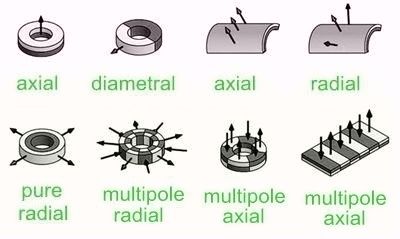Anisotropic are the most useful magnets available commercially. They have a preferred or easy direction of magnetization. An orientation field is used during the manufacturing process in the compaction phase.
It is not possible to magnetize the anisotropic magnet alloy except in the ’Orientation’ direction. Nevertheless, different pole configurations could be attained without disturbing the orientation of the magnet. Each magnet has a south seeking or a north seeking face at the opposite ends. Also, the south face of one magnet is always attracted to the north pole of another magnet.
Mentioned below are the standard and conventional industry options to magnetize the direction in Neodymium or Rare Earth Magnets. Neodymium magnets belong to the family of Rare Earth. They are the powerful permanent magnets available in the world. These magnets are also known as NIB or NdFeB magnets due to their composition, which is mainly Iron (Fe), Boron (B) and Neodymium (Nd). This is comparatively a new invention, and they have become affordable only recently for everyday use.

Neodymium Grades
US neodymium magnets are graded based type of material and they consist of like N38SH, N42, N38 and N35. As a rule, a magnet is stronger, when it is of higher grade. N52 is the highest grade neodymium magnet available now. If no letters follow the grade, the magnet is categorized as standard temperature neodymium.
Magnetization Options
- Rectangles/Cubes
Block Magnets are square/rectangular magnet that has three orientation directions. Hence, this type of magnet could be polarized in the desired direction.
- Through the Width – Here the magnetization is along the width and the strongest points are found at the ends. In a rectangle, width is generally the second biggest dimension.
- Through the Thickness – Here the magnetization is done along with the thickness. The strongest points are present at the ends. Generally, thickness is the smallest dimension.
- Through the Length – Here, the magnetization is along the length. The strongest points are along the length. Usually, in a rectangle shape, length is the biggest dimension.
- Arc Segment Geometry
It is possible to polarize an arc segment South or North on the outer radius. It is not easy to attain an accurate ‘radial’ orientation in the course of alignment/pressing stage of manufacturing. Therefore, Samarium Cobalt magnet, Ceramic magnet and Neodymium Iron Boron arcs are all specialized and rare.
- Chord Magnetized Arc – Here the magnetization is across the arc. The strongest points are along the even angled faces.
- Diametrically Magnetized Arc – Magnetization is done from the inner radius (r) all the way through the outer radius (R). The strongest points are found along the curved surfaces.
- Axially Magnetized Arcs – Magnetization is done through the thickness and the strongest points are found along the flat faces.
- Cup Magnets
A pot or cup magnet is a regular one found inside the stainless steel shell. The magnetic field is absorbed by the shell on one surface, and then it forces out in the opposite direction. This creates a dual pull at the end of a magnet.
- Axially Magnetized
The magnetization is along the diameter and the strongest points are present at the opposite ends.

